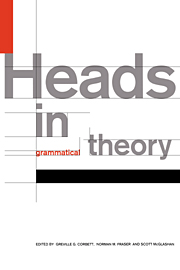Book contents
- Frontmatter
- Contents
- List of contributors
- 1 Introduction
- 2 The head of Russian numeral expressions
- 3 The phonology of heads in Haruai
- 4 Patterns of headedness
- 5 Head-hunting: on the trail of the nominal Janus
- 6 The headedness of noun phrases: slaying the nominal hydra
- 7 Head- versus dependent-marking: the case of the clause
- 8 Heads in discourse: structural versus functional centricity
- 9 Heads in Head-driven Phrase Structure Grammar
- 10 Heads and lexical semantics
- 11 Heads, parsing and word-order universals
- 12 Do we have heads in our minds?
- 13 Heads, bases and functors
- References
- Index
2 - The head of Russian numeral expressions
Published online by Cambridge University Press: 23 February 2010
- Frontmatter
- Contents
- List of contributors
- 1 Introduction
- 2 The head of Russian numeral expressions
- 3 The phonology of heads in Haruai
- 4 Patterns of headedness
- 5 Head-hunting: on the trail of the nominal Janus
- 6 The headedness of noun phrases: slaying the nominal hydra
- 7 Head- versus dependent-marking: the case of the clause
- 8 Heads in discourse: structural versus functional centricity
- 9 Heads in Head-driven Phrase Structure Grammar
- 10 Heads and lexical semantics
- 11 Heads, parsing and word-order universals
- 12 Do we have heads in our minds?
- 13 Heads, bases and functors
- References
- Index
Summary
Introduction
A major focus of the debate on headedness has been the problem of determining the head in different constructions and of establishing acceptable criteria to enable us to do so. The data have been taken mainly from English, and so this account, by contrast, extends the investigation to a language with a much richer morphological system than that of English, namely Russian. We shall concentrate on numeral expressions in Russian, where the head-dependent relation has long been known to be problematic (see, for example, Isačenko, 1962: 529). We shall examine them in the light of the criteria for heads proposed by Zwicky (1985) and by Hudson (1987). At first sight it seems that no single head can be identified for these constructions; rather, the properties of the head appear to be shared between different elements, which would fit with Zwicky's approach. However, given current assumptions about lexical entries and feature distribution, these constructions can be analysed as being rather less exotic than they first appear, and as having a consistent head, as Hudson would predict. While attempting to remain as theory-neutral as possible, we shall develop the analysis to see whether the idea of a single element having all the head properties can be maintained. It is in focusing on the question of headedness that this chapter differs from most previous accounts of Russian numeral phrases. We shall see that there are two consequences. The first is that we still need to recognize that headedness is a gradient notion: a particular element may have head-like characteristics to a greater or lesser degree, and that these may vary according to external factors (notably, case assignment).
- Type
- Chapter
- Information
- Heads in Grammatical Theory , pp. 11 - 35Publisher: Cambridge University PressPrint publication year: 1993
- 1
- Cited by



